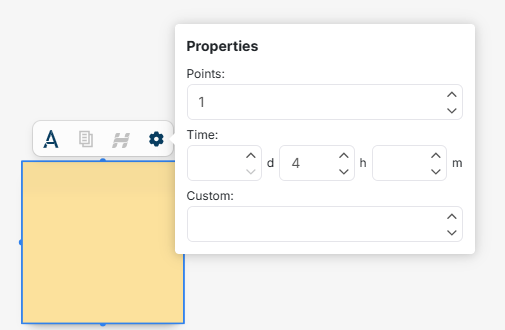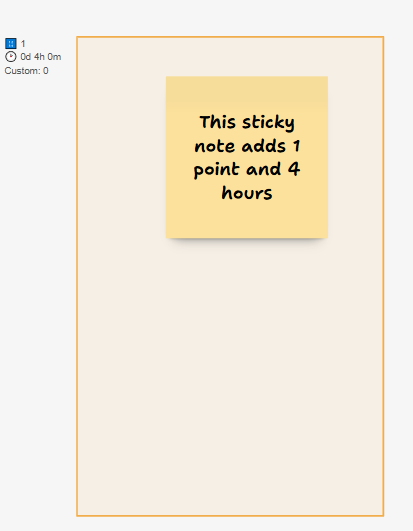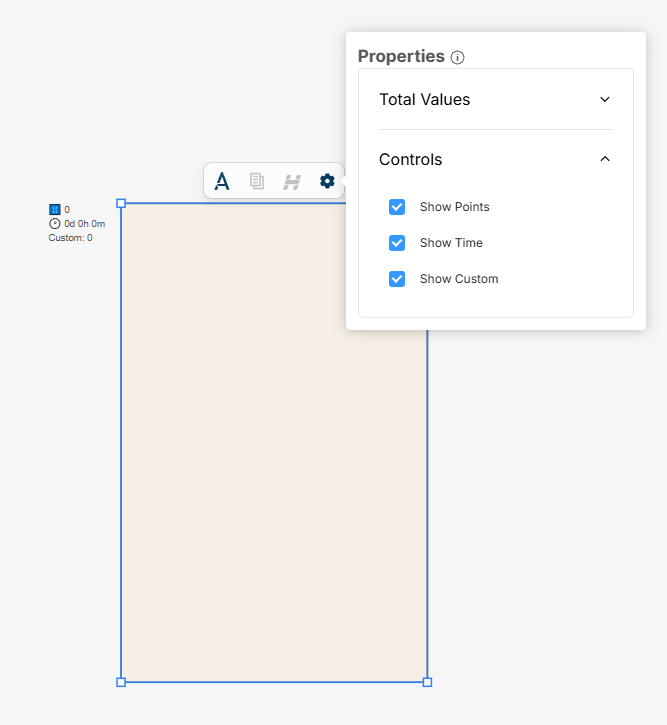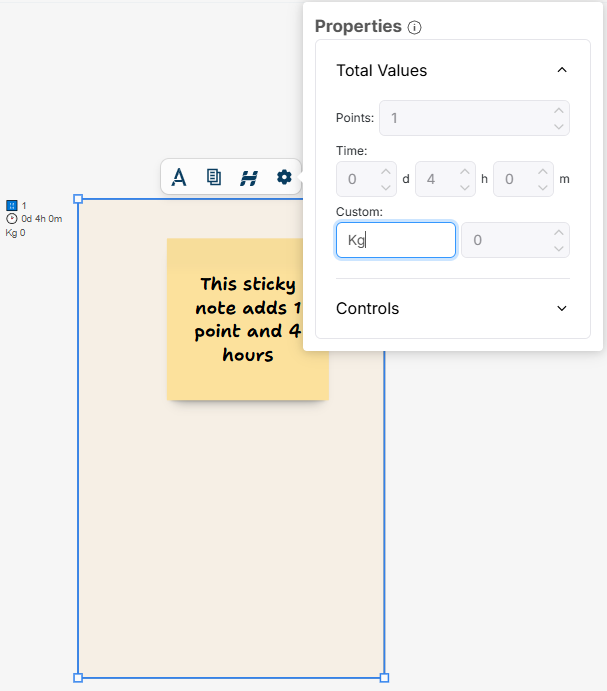When you first look at a Superframe in Hanna Boards, you'll see what appears to be a simple frame or container on your board. However, this powerful control is much more than meets the eye—it's an intelligent container that automatically calculates and displays totals for any elements you place inside it.

Let's start with the basics of how controls work in Hanna Boards. Every control, whether it's a sticky note, a label, or any other element, has properties that you can access. When you click on any control, you'll notice a small gear icon appears in the top right corner. This gear icon is your gateway to setting properties for that specific element.

When you click on this gear icon, you'll see three properties that you can set: Points, Time, and Custom values.
- Points allow you to assign any numerical value—think of it as a scoring system where you might assign 1 point to a simple task or 5 points to a complex one.
- Time lets you specify duration using a combination of days, hours, and minutes.
- The Custom value is exactly what it sounds like—a flexible number that can represent anything you need, from budget figures to quantity counts.

Now, here's where the magic of the Superframe comes in. When you place any object inside a Superframe, it automatically starts tracking these properties.

Let's say you're planning a marketing campaign. You might have several tasks represented by sticky notes inside your Superframe. One task might be worth 3 points and take 2 days, another might be worth 2 points and take 4 hours, and a third might have a custom value representing a $500 budget. The Superframe automatically adds all these values and displays the totals in the top left corner.

The Superframe itself also has properties, accessed through its own gear icon. These properties show you the current totals (which are read-only since they're calculated automatically) and give you control over what information is displayed. You can choose to show or hide points, time, and custom values depending on what's relevant for your specific needs.
Custom Values
One particularly useful feature is the ability to customize the label for your custom values. For instance, if you're tracking budget, you might want to label it with a dollar sign ($). If you're tracking inventory, you might label it "Units" or "Items." This flexibility allows the Superframe to adapt to whatever metrics you need to monitor.

As you work with your board, the Superframe updates in real-time. Add a new task with 2 points? The total updates instantly. Remove an element? The totals adjust automatically. This immediate feedback makes it incredibly valuable for planning and people management.
Think of a Superframe as your personal calculator and organizer combined. It not only helps you keep related items together visually but also does all the mathematical heavy lifting for you. No more manual adding or recalculating when things change - the Superframe handles all of that automatically.
Nested Superframes
Now that we understand the basics of Superframes, let's explore their more advanced capabilities and how they can transform your business operations. One of the most powerful features is the ability to nest Superframes within each other (Nested Superframes), creating a hierarchical structure that mirrors your organization or iniciative breakdown.
Imagine you're managing a large organization. You might create a main Superframe representing the entire company. Within this main frame, you could have separate Superframes for each department—Marketing, Sales, Development, and so on. Each department's Superframe could further contain individual team Superframes. What makes this structure powerful is that each Superframe calculates its own totals while also contributing to the calculations of its parent Superframe.
For example, let's say you're tracking initiative workload across your organization. The Marketing department's Superframe might contain three team Superframes: Digital, Events, and Content. Each team's Superframe contains their specific initiative and tasks. As team members add points, time, or custom values to their tasks, these values automatically roll up through the hierarchy. The Digital team's total feeds into the Marketing department's total, which in turn contributes to the company-wide total in the main Superframe.
The real power of nested Superframes becomes apparent when you need to reorganize or test different scenarios. Want to see how moving an entire project team from one department to another would affect workload distribution? Simply drag one Superframe into another, and all the calculations update instantly. This makes it an invaluable tool for organizational planning, people, and resource optimization.
Using Mixed Metrics
Superframes also excel at handling mixed metrics. A single object within a Superframe can have any combination of points, time, and custom values. For instance, an initiaitve might have both a complexity score (points), an estimated duration (time), and a budget (custom value). The Superframe handles these different metrics simultaneously, keeping each type of measurement separate in its calculations.
The time calculations are particularly sophisticated. The Superframe automatically handles conversions between days, hours, and minutes. If one task takes 2 days and another takes 36 hours, the Superframe will intelligently combine these into a meaningful total. You don't need to worry about the math - it's all handled automatically.
For strategic planning, Superframes offer unprecedented flexibility. You can use them to model different organizational structures, test people and resource allocations, or track progress toward goals. For example, if you're planning a company-wide initiative, you could create Superframes for different implementation scenarios, easily comparing the resource requirements and implications of each approach.
The custom label feature becomes especially valuable in complex business environments. Different departments might need to track different metrics—Sales might track revenue in dollars, Operations might track units produced, and People and Culture might track headcount. Each Superframe can have its own custom label, making it clear exactly what's being measured.
One practical application is in portfolio management. Create a Superframe for each inictiative portfolio, with individual initiative Superframes nested inside. Use points to track complexity, time for duration, and custom values for budget. At a glance, you can see how resources are distributed across your portfolio, identify overloaded areas, and make informed decisions about initiative prioritization.
The absence of limitations on values or the number of objects means Superframes can scale with your needs. Whether you're managing a small team project or coordinating a global enterprise, Superframes can handle the complexity while keeping the information organized and accessible.
Remember, while Superframes are performing complex calculations behind the scenes, their strength lies in their simplicity of use. They provide clear, real-time insights without requiring complex setup or maintenance. As your organization's needs evolve, Superframes can be easily adjusted to track different metrics or reorganized to reflect new structures.